Best known for his world-renowned neuro-ophthalmology unit based at the University of California, San Francisco, William Hoyt, MD collected here more than 850 of his best images covering a wide range of disorders.
William F. Hoyt, MD, Professor Emeritus of Ophthalmology, Neurology and Neurosurgery, Department of Ophthalmology, University of California, San Francisco.
NOVEL: https://novel.utah.edu/
TO
| Title | Description | Type | ||
|---|---|---|---|---|
| 1 |
 |
A101 Disc Swelling due to Intraocular Hypotension | Ocular hypotension following lens replacement surgery. Retinal/macular folds. Anatomy: Optic disc. Pathology: Disc edema. Disease/ Diagnosis: Intraocular hypotension. Clinical: Low intraocular pressure or intraocular hypotension. | Image |
| 2 |
 |
A201 Disc Swelling with Big Blind Spot Syndrome | Blind spot larger than could be explained by visible edema. Subretinal white dots probably indicate margin of blind spot. Anatomy: Optic disc; Retina. Pathology: Unknown. Disease/ Diagnosis: Big blind spot syndrome. Clinical: symptoms: photosias, blurred vision signs: Disc swelling; white spots in t... | Image |
| 3 |
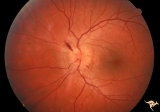 |
A202 Disc Swelling with Big Blind Spot Syndrome | Blind spot larger than could be explained by visible disc edema. Reference: Fletcher WA, Imes RK, Goodman D, Hoyt WF. Acute idiopathic blind spot enlargement. A big blind spot disc edema. Arch Ophthalmol. 1988 Jan;106(1):44-9. Anatomy: Optic disc; Retina. Pathology: Unknown. Disease/ Diagnosis: Big ... | Image |
| 4 |
 |
A203 Disc Swelling with Big Blind Spot Syndrome | Slight inferior swelling in patient with grossly enlarged blind spot. 66 year old woman. Anatomy: Optic disc; Retina. Pathology: Unknown. Disease/ Diagnosis: Big blind spot syndrome. Clinical: symptoms: photopsias; blurred vision signs: disc swelling; white dots in the retina; enlarged blind spot on... | Image |
| 5 |
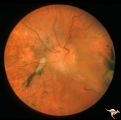 |
A301a Disc Swelling, Chorioretinal Disease | a and b same eye. Bad chorioretinal scars with disc swelling. Anatomy: Optic disc. Pathology: Unknown. | Image |
| 6 |
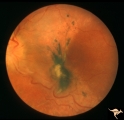 |
A302b Disc Swelling, Chorioretinal Disease | Bad chorioretinal scars with disc swelling. Temporal extent of chorioretinal scarring. A and B are the same eye. Anatomy: Optic disc. Pathology: Unknown. | Image |
| 7 |
 |
A303 Disc Swelling, Chorioretinal Disease | Neovascular net. Disc swelling with peripapillary neo-vascularization with subretinal hemorrhage. Anatomy: Optic disc; Retina. | Image |
| 8 |
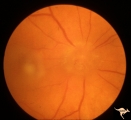 |
A401Disc Swelling, Vitreous Effects | Vitreopapillary haze. Cone of vitreous that has obscured the disc. Uveitis patient. Anatomy: Optic disc; Vitreous. Pathology: Vitreal contact with the optic disc. Disease/ Diagnosis: Vitreal traction on the disc? Clinical: Visual blurring in uveitis?¼igns: disc swelling; disc obscuration. | Image |
| 9 |
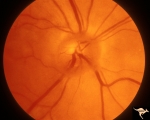 |
A402a Disc Swelling, Vitreous Effects | Posterior vitreous detachment with vitreo papillary adherence to the optic disc. See fluorescein angiogram A43b. Anatomy: Optic disc; Vitreous. Pathology: Posterior vitreous detachment with vitreo papillary adherence to the optic disc. Disease/ Diagnosis: Disc swelling due to vitreo papilary adheren... | Image |
| 10 |
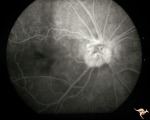 |
A403b Disc Swelling, Vitreous Effects | Fluorescein angiogram shows fluorescein leaking around entire disc where attachment of vitreous exists. Refers to A402a. Anatomy: Optic disc; Vitreous. Pathology: Disc swelling due to posterior vitreal detachment. Disease/ Diagnosis: Disc swelling due to posterior vitreal detachment. Clinical: float... | Image |
| 11 |
 |
A404 Disc Swelling, Vitreous Effects | Disc elevation (swelling) and vitritis. Posterior vitreous detachment with vitritis. Incidental choroidal nevus. Anatomy: Optic disc; Vitreous; Retina. Pathology: Posterior vitreal detachment, disc swelling, and vitritis-horoidal nevus. Disease/ Diagnosis: Vitreal detachment from optic disc; choroid... | Image |
| 12 |
 |
A405 Disc Swelling, Vitreous Effects | Prepapillary hemorrhage. Partial posterior vitreous detachment in myopic Asian patient. Reference: Katz B, Hoyt WF. Intrapapillary and peripapillary hemorrhage in young patients with incomplete posterior vitreous detachment. Signs of vitreopapillary traction. Ophthalmology. 1995 Feb;102(2):349-54. ... | Image |
| 13 |
 |
A406 Disc Swelling, Vitreous Effects | Prepapillary hemorrhage. Partial posterior vitreous detachment in myopic Asian patient. Reference: Katz B, Hoyt WF. Intrapapillary and peripapillary hemorrhage in young patients with incomplete posterior vitreous detachment. Signs of vitreopapillary traction. Ophthalmology. 1995 Feb;102(2):349-54. A... | Image |
| 14 |
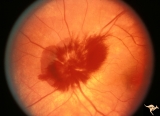 |
A407 Disc Swelling, Vitreous Effects | Prepapillary hemorrhage. Partial posterior vitreous detachment in myopic patient. Reference: Katz B, Hoyt WF. Intrapapillary and peripapillary hemorrhage in young patients with incomplete posterior vitreous detachment. Signs of vitreopapillary traction. Ophthalmology. 1995 Feb;102(2):349-54. Anatomy... | Image |
| 15 |
 |
A408 Disc Swelling, Vitreous Effects | Prepapillary hemorrhage. Partial posterior vitreous detachment in myopic Asian patient. Reference: Katz B, Hoyt WF. Intrapapillary and peripapillary hemorrhage in young patients with incomplete posterior vitreous detachment. Signs of vitreopapillary traction. Ophthalmology. 1995 Feb;102(2):349-54. A... | Image |
| 16 |
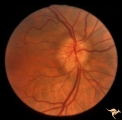 |
A501 Disc Swelling, Pre-Ischemic Swelling | Pre AION swelling. Asymptomatic on October 8, 1985. Same patient as A5_2b. Anatomy: Optic disc. Pathology: Axoplasmic stasis due to ischemia. Disease/ Diagnosis: Pre AION, Pre ischemic swelling. Clinical: Asymptomatic. | Image |
| 17 |
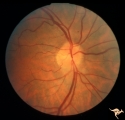 |
A502 Disc Swelling, Pre-Ischemic Swelling | Pre AION swelling. Cleared after 8 days. October 16, 1985. Disc swelling resolved. arterioles at 6:00 and 12:30 have focal narrowing. Patient did not lose vision. Same patient as A5_1a. Anatomy: Optic disc. Pathology: Normal. Disease/ Diagnosis: Resolved pre-AION swelling; Resolved pre ischemic swel... | Image |
| 18 |
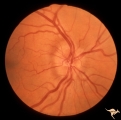 |
A503 Disc Swelling, Pre-Ischemic Swelling | Pre-ischemic swelling. March 22, 1983. Same patient as A5_4d. Anatomy: Optic disc. Pathology: Axoplasmic stasis due to ischemia. Disease/ Diagnosis: Pre-AION; Pre-ischemic swelling. Clinical: Asymptomatic. | Image |
| 19 |
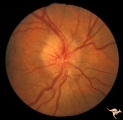 |
A504 Disc Swelling, Pre-Ischemic Swelling | AION with altitudinal visual loss. July 7, 1983. Same patient as A5_3c. Anatomy: Optic disc. Pathology: Axoplasmic stasis due to ischemia. Disease/ Diagnosis: AION. Clinical: Altitudinal visual field loss due to AION. | Image |
| 20 |
 |
B101 Disc Swelling, Ischemic Papillopathies, AION | Pallid swelling in course of acute AION. 48 year old man who developed disc swelling after a flu like illness, then developed AION. Anatomy: Optic disc. Pathology: Axoplasmic stasis due to ischemia. Disease/ Diagnosis: AION. Clinical: Visual loss after flu-like illness. | Image |
| 21 |
 |
B102 Disc Swelling, Ischemic Papillopathies, AION | Ischemic swelling. March 2, 1978. Same patient as B1_03. Anatomy: Optic disc. Pathology: Axoplasmic stasis due to ischemia. Disease/ Diagnosis: AION. Clinical: Diabetic with optic disc swelling and visual loss. | Image |
| 22 |
 |
B103 Disc Swelling, Ischemic Papillopathies, AION | Ischemic swelling. 50 year old woman, 12 days after a viral illness. Nasal nerve fiber layer bundle visual field defect. Anatomy: Optic disc. Pathology: Axoplasmic stasis due to ischemia. Disease/ Diagnosis: AION. Clinical: Visual loss after viral illness. | Image |
| 23 |
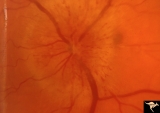 |
B104 Disc Swelling, Ischemic Papillopathies, AION | Ischemic swelling. 57 year old man. Anatomy: Optic disc. Pathology: Axoplasmic stasis due to ischemia. Disease/ Diagnosis: AION. Clinical: Visual loss. | Image |
| 24 |
 |
B105 Disc Swelling, Ischemic Papillopathies, AION | Pallid ischemic swelling. 48 year old woman, flight attendant. Anatomy: Optic disc. Pathology: Axoplasmic stasis due to ischemia. Disease/ Diagnosis: AION. Clinical: Visual loss. | Image |
| 25 |
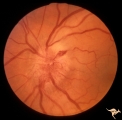 |
B106 Disc Swelling, Ischemic Papillopathies, AION | Red ischemic swelling. 49 year old man. Anatomy: Optic disc. Pathology: Axoplasmic stasis due to ischemia. Disease/ Diagnosis: AION. Clinical: Visual loss. | Image |
| 26 |
 |
B107 Disc Swelling, Ischemic Papillopathies, AION | Pallid ischemic swelling. 41 year old man. Anatomy: Optic disc. Pathology: Axoplasmic stasis due to ischemia. Disease/ Diagnosis: AION. Clinical: Viusal loss. | Image |
| 27 |
 |
B108 Disc Swelling, Ischemic Papillopathies, AION | Pallid ischemic swelling. Woman with vasculitis. Anatomy: Optic disc. Pathology: Axoplasmic stasis due to ischemia. Disease/ Diagnosis: AION. Clinical: Visual loss. | Image |
| 28 |
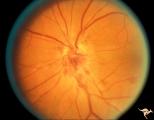 |
B109 Disc Swelling, Ischemic Papillopathies, AION | Ischemic swelling. Patient was diabetic. April 18, 1978. Same patient as B1-2. Anatomy: Optic disc. Pathology: Axoplasmic stasis due to ischemia. Disease/ Diagnosis: AION. Clinical: Diabetic with disc swelling and visual loss. | Image |
| 29 |
 |
B111 Disc Swelling, Ischemic Papillopathies, AION | Acute AION. Anatomy: Optic disc. Pathology: Axoplasmic stasis due to ischemia. Disease/ Diagnosis: AION. Clinical: Visual loss. | Image |
| 30 |
 |
B112 Disc Swelling, Ischemic Papillopathies, AION | Arterioles are narrowing in resolution phase from AION. Patient had a superior altitudinal visual field defect. 20 year old man. Anatomy: Optic disc. Pathology: Axoplasmic stasis due to ischemia. Disease/ Diagnosis: AION. Clinical: Visual loss. | Image |
| 31 |
 |
B114 Disc Swelling, Ischemic Papillopathies, AION | AION in a disc with an optic cup. Extraordinary exception with AION. Note ischemic vascular changes in disc surface. Anatomy: Optic disc. Pathology: Axoplasmic stasis due to ischemia. Disease/ Diagnosis: AION. Clinical: Visual loss. | Image |
| 32 |
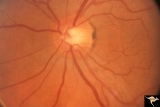 |
B115 Disc Swelling, Ischemic Papillopathies, AION | Normal eye in patient who later developed AION. Note generous optic cup. June 2, 1991. Same patient as B1_16b. Anatomy: Optic disc. Pathology: Normal. Clinical: Asymptomatic. | Image |
| 33 |
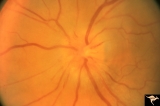 |
B116 Disc Swelling, Ischemic Papillopathies, AION | Typical AION in disc with optic cup. December 23, 2996. 5 years later in same patient as B1_15a. Anatomy: Optic disc. Pathology: Axoplasmic stasis due to ischemia. Disease/ Diagnosis: AION. Clinical: Visual loss. | Image |
| 34 |
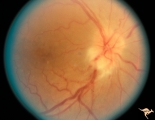 |
B201 Disc Swelling, Diabetic Papillopathy | Bilateral simultaneous diabetic papillopathy with marked exudation and remarkable recovery of vision. Right eye. Pair with B2_2b. Anatomy: Optic disc. Pathology: Axoplasmic stasis due to ischemia. Disease/ Diagnosis: Diabetic papillopathy. Clinical: Visual loss. | Image |
| 35 |
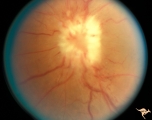 |
B202 Disc Swelling, Diabetic Papillopathy | Bilateral diabetic papillopathy with marked exudation and remarkable recovery of vision. Left eye. Pair with B2_1a. Anatomy: Optic disc. Pathology: Axoplasmic stasis due to ischemia. Disease/ Diagnosis: Diabetic papillopathy. Clinical: Visual loss with recovery. | Image |
| 36 |
 |
B203 Disc Swelling, Diabetic Papillopathy | Disc swelling in a diabetic woman. Recovered without visual loss. Right eye. Pair with B2_04. Anatomy: Optic disc. Pathology: Axoplasmic stasis due to ischemia. Disease/ Diagnosis: Diabetic papillopathy. Clinical: Visual loss with recovery. | Image |
| 37 |
 |
B204 Disc Swelling, Diabetic Papillopathy | Disc swelling in a diabetic. Recovered without visual loss. Left eye. Pair with B2_03. Anatomy: Optic disc. Pathology: Axoplasmic stasis due to ischemia. Disease/ Diagnosis: Diabetic papillopathy. Clinical: Visual loss with recovery. | Image |
| 38 |
 |
B205 Disc Swelling, Diabetic Papillopathy | Bilateral diabetic papillopathy. Girl. Left eye. Pair with B2_06. Anatomy: Optic disc. Pathology: Axoplasmic stasis due to ischemia. Disease/ Diagnosis: Diabetic papillopathy. Clinical: Visual loss with recovery. | Image |
| 39 |
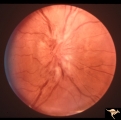 |
B206 Disc Swelling, Diabetic Papillopathy | Bilateral diabetic papillopathy. Girl. Right eye. Pair with B2_05. Anatomy: Optic disc. Pathology: Axoplasmic stasis due to ischemia. Disease/ Diagnosis: Diabetic papillopathy. Clinical: Visual loss with recovery. | Image |
| 40 |
 |
B301 Disc Swelling, Giant Cell Arteritis | Disc swelling. Giant Cell Arteritis. Temporal. Ischemic swelling. Blind eye with pallid swelling and marked dilation of central retinal vein. | Image |
| 41 |
 |
B401 Disc Swelling, Radiation Papillopathy | Male with blind eye. Marked peripapillary intraretinal exudate. April 1985. Same patient as B402, B407. Anatomy: Optic disc. Pathology: Axoplasmic stasis due to ischemia. Disease/ Diagnosis: Radiation papillopathy; radiation optic neuropathy. Clinical: Visual loss after radiation therapy. | Image |
| 42 |
 |
B402 Disc Swelling, Radiation Papillopathy | Radiation papillopathy with arterial narrowing, exudation and venous dilation in man with blind eye. May 1985. Same patient as B401, B407. Anatomy: Optic disc. Pathology: Axoplasmic stasis due to ischemia. Disease/ Diagnosis: Radiation papillopahty; optic neuropathy. Clinical: Visual loss after radi... | Image |
| 43 |
 |
B403 Disc Swelling, Radiation Papillopathy | Man with blind eye. Ischemic hemorrhages. Vitreous haze. Anatomy: Optic disc. Pathology: Axoplasmic stasis due to ischemia. Disease/ Diagnosis: Radiation papillopathy; optic neuropathy. Clinical: Visual loss after radiation therapy. | Image |
| 44 |
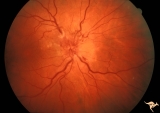 |
B404 Disc Swelling, Radiation Papillopathy | Marked vascular changes in the swollen optic disc. Probably not blind. Male. Right eye. Anatomy: Optic disc. Pathology: Axoplasmic stasis due to ischemia. Disease/ Diagnosis: Radiation Papillopathy; Optic neuropathy. Clinical: Visual loss after radiation therapy. | Image |
| 45 |
 |
B405 Disc Swelling, Radiation Papillopathy | Bilateral blindness 6 months post radiation for malignant glioma of left hemisphere. Left eye. Marked white exudation probably represents necrosis of swollen disc tissue. Japanese patient. Anatomy: Optic disc. Pathology: Axoplasmic stasis due to ischemia. Disease/ Diagnosis:Radiation papillopathy; O... | Image |
| 46 |
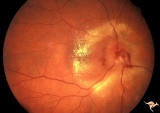 |
B406 Disc Swelling, Radiation Papillopathy | Note the marked vascular changes on the disc surface and the interesting distribution of intraretinal exudate. Patient had vision with large blind spot. Woman. Right eye. Visual field showed only an enlarged blind spot. Anatomy: Optic disc. Pathology: Axoplasmic stasis due to ischemia. Disease/ Diag... | Image |
| 47 |
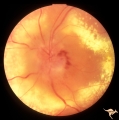 |
B407 Disc Swelling, Radiation Papillopathy | Man with blind eye. June 1985. Same patient as B401 and B402. Note the striking peripapillary intraretinal exudatation occurring at a slight distance from the disc. Anatomy: Optic disc. Pathology: Axoplasmic stasis due to ischemia; Ischemic infarction. Disease/ Diagnosis: Radiation papillopathy; Opt... | Image |
| 48 |
 |
Bilateral Chronic Papilledema | Left eye. Frisen's stage 5. Patient with long standing aqueductal stenosis. Bilateral Chronic Papilledema. Man. Anatomy: Optic disc. Pathology: Papilledema. Disease/Diagnosis: Papilledema from aqueductal stenosis. | Image |
| 49 |
 |
Bilateral Chronic Papilledema | Right eye. Frisen's stage 5. Patient with long standing aqueductal stenosis. Bilateral Chronic Papilledema. Man. Anatomy: Optic disc. Pathology: Papilledema. Disease/Diagnosis: Papilledema from aqueductal stenosis. | Image |
| 50 |
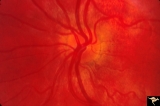 |
Bilateral Crowded Discs | Left eye. Bilateral crowded discs with congenital blurring. Blurred disc margins are not from edema. Note optic cup is absent. Pair with right eye in PP_1a, and brother in PP_2. Mother has drusen of the optic disc in PP_11aa & b. Sister has drusen in PP_11c. Anatomy: Optic disc. Pathology: Normal va... | Image |
| 51 |
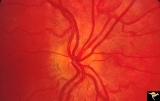 |
Bilateral Crowded Discs (Family) | Right eye. Bilateral crowded discs with congenital blurring. Blurred disc margins are not from edema. Note optic cup is absent. Pair with left eye in PP_1b, and brother in PP_2. Mother has drusen of the optic disc in PP_11a & b. Sister has drusen in PP_11c. Anatomy: Optic disc. Pathology: Normal var... | Image |
| 52 |
 |
Bilateral Hemorrhagic Papilledema | Left eye. Bilateral Hemorrhagic Papilledema from cardio-respiratory disease. Woman. Anatomy: Optic disc. Pathology: Bilateral papilledema, hemorrhagic. Disease/Diagnosis: Pseudotumor due to cardio-respiratory disease. Clinical notes: Woman with headache, shortness of breath. | Image |
| 53 |
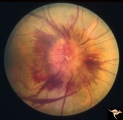 |
Bilateral Hemorrhagic Papilledema | Bilateral Hemorrhagic Papilledema from cardio-respiratory disease. Woman. Anatomy: Optic disc. Pathology: Bilateral papilledema, hemorrhagic. Disease/Diagnosis: Pseudotumor due to cardio-respiratory disease. Clinical notes: Woman with headache, shortness of breath. | Image |
| 54 |
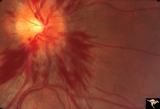 |
Bilateral Hemorrhagic Papilledema from Saggital Sinus Thrombosis | Left eye. 20 year old woman on oral contraceptives. Bilateral hemorrhagic Papilledema from sagittal sinus thrombosis. Anatomy: Optic disc. Pathology: Papilledema; hemorrhagic papilledema. Disease/Diagnosis: Superior saggital sinus thrombosis due to BCP use. Clinical notes: Chronic headache. | Image |
| 55 |
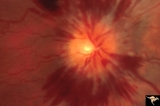 |
Bilateral Hemorrhagic Papilledema from Saggital Sinus Thrombosis | Right eye. 20 year old woman on oral contraceptives. Bilateral hemorrhagic Papilledema from sagittal sinus thrombosis. Anatomy: Optic disc. Pathology: Papilledema; hemorrhagic papilledema. Disease/Diagnosis: Superior sagittal sinus thrombosis due to BCP use. Clinical notes: Chronic headache. | Image |
| 56 |
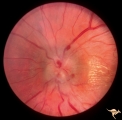 |
Bilateral Papilledema | Left eye. Has intra-retinal exudate and unusual vascular changes in the optic disc. Pre-pubertal girl. Anatomy: Optic disc. Pathology: Bilateral papilledema; exudative deposits in macula. Disease/Diagnosis: Pseudotumor. Clinical: Pubertal girl; headaches. | Image |
| 57 |
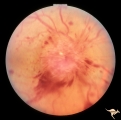 |
Bilateral Papilledema | Right eye. Bilateral Papilledema in 410 pound man with tracheostomy for pulmonary insufficiency. Anatomy: Optic disc. Pathology: Papilledema. Disease/Diagnosis: Pseudotumor due to: sleep apnea due to cardiopulmonary insufficiency syndrome. Pickwickian syndrome. Clinical notes: Headache; obesity. | Image |
| 58 |
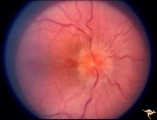 |
Bilateral Papilledema | Right eye. Bilateral Papilledema in patient with cardiopulmonary insufficiency. Woman. Anatomy: Optic disc. Pathology: Papilledema. Disease/Diagnosis: cardiopulmonary insufficiency causing intracranial hypertension. Clinical notes: headache. | Image |
| 59 |
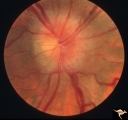 |
Bilateral Papilledema | Right eye. Bilateral Papilledema in a patient with hyperthyroidism. Woman. Anatomy: Optic disc. Pathology: Papilledema. Disease/Diagnosis: Bilateral papilledema with hyperthyroidism. | Image |
| 60 |
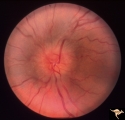 |
Bilateral Papilledema | Left eye. Bilateral Papilledema with hypoparathyroidism. Woman. Anatomy: Optic disc. Pathology: Papilledema. Papilledema with hypopararthyroidism. | Image |
| 61 |
 |
Bilateral Papilledema | Picture of patient. 410 pound man with tracheostomy done for sleep apnea due to cardiopulmonary insufficiency syndrome. Pickwickian syndrome. Anatomy: Optic disc. Pathology: Papilledema. Disease/Diagnosis: Pseudotumor due to: sleep apnea due to cardiopulmonary insufficiency syndrome. Pickwickian syn... | Image |
| 62 |
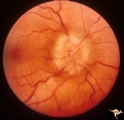 |
Bilateral Papilledema | Right eye. Bilateral Papilledema from vitamin A toxicity. Vitamin A pseudotumor cerebri syndrome in a 25 year old weight lifter. Anatomy: Optic disc. Pathology: Bilateral papilledema. Disease/Diagnosis: Pseudotumor due to vitamin A toxicity and weight lifting. Clinical notes: Headache, weight lifter... | Image |
| 63 |
 |
Bilateral Papilledema | Left eye. Bilateral Papilledema in patient with cardiopulmonary insufficiency. Woman. Anatomy: Optic disc. Pathology: Papilledema. Disease/Diagnosis: Cardiopulmonary insufficiency causing intracranial hypertension. Clinical notes: Headache. | Image |
| 64 |
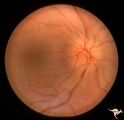 |
Bilateral Papilledema | Right eye. Bilateral Papilledema with hypoparathyroidism. Woman. Anatomy: Optic disc. Pathology: Papilledema. Disease/Diagnosis: Papilledema with hypoparathyroidism. | Image |
| 65 |
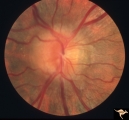 |
Bilateral Papilledema | Left eye. Bilateral Papilledema in a patient with hyperthyroidism. Woman. Anatomy: Optic disc. Pathology: Papilledema. Disease/Diagnosis: Bilateral papilledema. | Image |
| 66 |
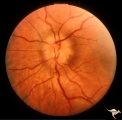 |
Bilateral Papilledema | Left eye. Bilateral Papilledema from vitamin A toxicity. Vitamin A pseudotumor cerebri syndrome in a 25 year old weight lifter. Anatomy: Optic disc. Pathology: Bilateral papilledema. Disease/Diagnosis: Pseudotumor due to vitamin A toxicity and weight lifting. Clinical notes: Headache, weight lifter. | Image |
| 67 |
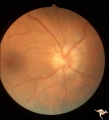 |
Bilateral Papilledema | Left eye. Chronic Bilateral Papilledema. Anatomy: Optic disc. Pathology: Chronic bilateral papilledema. Disease/Diagnosis: Pseudotumor long standing. Clinical notes: Chronic headache; Obesity. | Image |
| 68 |
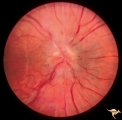 |
Bilateral Papilledema | Right eye. Pre-pubertal girl. Anatomy: Optic disc. Pathology: Bilateral papilledema; exudative deposits in macula. Disease/Diagnosis: Pseudotumor. Clinical notes: Pubertal girl; headaches. | Image |
| 69 |
 |
Bilateral Papilledema | Left eye. Bilateral Papilledema from vitamin A toxicity in young girl. Anatomy: Optic disc. Pathology: Bilateral papilledema. Disease/Diagnosis: Pseudotumor due to vitamin A toxicity in a young girl. Clinical notes: Headache. | Image |
| 70 |
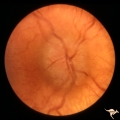 |
Bilateral Papilledema | Right eye. Bilateral Papilledema from vitamin A toxicity in young girl. Anatomy: Optic disc. Pathology: Bilateral papilledema. Disease/Diagnosis: Pseudotumor due to vitamin A toxicity in a young girl. Clinical notes: Headache. | Image |
| 71 |
 |
Bilateral Papilledema | Chronic Bilateral Papilledema. Anatomy: Optic disc. Pathology: Chronic bilateral papilledema. Disease/Diagnosis: Pseudotumor long standing. Clinical notes: Chronic headache; Obesity. | Image |
| 72 |
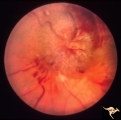 |
Bilateral Papilledema from Occipital Tumor | Left eye. Bilateral hemorrhagic papilledema. Occipital glioma. Woman. Anatomy: Optic disc. Pathology: Papilledema. Disease/Diagnosis: Hemorrhagic papilledema from occipital glioma. | Image |
| 73 |
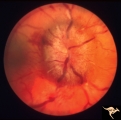 |
Bilateral Papilledema from Occipital Tumor | Right eye. Bilateral hemorrhagic papilledema. Occipital glioma. Right hemianopia. Woman. Anatomy: Optic disc. Pathology: Papilledema. Disease/Diagnosis: Hemorrhagic papilledema from occipital glioma. | Image |
| 74 |
 |
Bilateral Papilledema from Pseudotumor | Left eye. Atrophic changes in left optic disc. Chronic papilledema with involution to atrophy on the left. Woman. Anatomy: Optic disc. Pathology: Bilateal papilledema; atrophic papilledema. Disease/Diagnosis: Pseudotumor. Clinical: Headache. | Image |
| 75 |
 |
Bilateral Papilledema from Pseudotumor | Right eye. Pseudotumor syndrome. Multiple endocrine adenomas. Woman. Anatomy: Optic disc. Pathology: Bilateral papilledema. Disease/Diagnosis: Pseudotumor associated with multiple endocrine adenomas. Clinical notes: Headache; Obesity. | Image |
| 76 |
 |
Bilateral Papilledema from Pseudotumor | Right eye. Chronic papilledema. Woman. Anatomy: Optic disc. Pathology: Bilateral papilledema; atrophic papilledema. Disease/Diagnosis: Pseudotumor. Clinical notes: Headache. | Image |
| 77 |
 |
Bilateral Papilledema in Pseudotumor | Left eye. Pseudotumor syndrome. Multiple endocrine adenomas. Woman. Anatomy: Optic disc. Pathology: Bilateral papilledema. Disease/Diagnosis: Pseudotumor associated with multiple endocrine adenomas. Clinical notes: Headache; Obesity. | Image |
| 78 |
 |
Bilateral Papilledema with Cyanotic Heart Disease | Bilateral Papilledema with cyanotic heart disease in a young boy. Anatomy: Optic disc. Pathology: Papilledema. Disease/Diagnosis: Pseudotumor due to cyanotic heart disease. Clinical notes: Young boy with clubbing. | Image |
| 79 |
 |
Bilateral Papilledema with Exudative Retinopathy | Bilateral Papilledema with exudative retinopathy from vitamin A toxicity. Young boy. Near blind. Anatomy: Optic disc; Retina. Pathology: Bilateral papilledema; exudative retinopathy. Disease/Diagnosis: Hypervitaminosis A causing blindness. Clinical notes: Nearly blind; Headache. | Image |
| 80 |
 |
Bilateral Papilledema with Pseudotumor Cerebri | Right eye. Mild bilateral papilledema in a 7 year old boy. Cause of swelling unknown. Growth failure treated with thyroid medication. Anatomy: Optic disc. Pathology: Bilateral papilledema. Disease/Diagnosis: Intracranial hypertension due to treatment of growth failure with thyroid medicaltion. Clini... | Image |
| 81 |
 |
Bilateral Papilledema with Pseudotumor Cerebri | Left eye. Mild bilateral papilledema in a 7 year old boy. Cause of swelling unknown. Growth failure treated with thyroid medication. Anatomy: Optic disc. Pathology: Bilateral papilledema. Disease/Diagnosis: Intracranial hypertension due to treatment of growth failure with thyroid medication. Clinica... | Image |
| 82 |
 |
Bilateral Papilledema with Pseudotumor Cerebri | Chronic appearance of swelling in right eye. 29 year old woman. Bilateral papilledema. Anatomy: Optic disc. Pathology: Bilateral papilledema. Disease/Diagnosis: Intracranial hypertension due to treatment of growth failure with thyroid medication. Clinical: symptoms: headache, signs: bilateral papill... | Image |
| 83 |
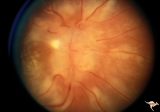 |
Bilateral Severe Hemorrhagic Papilledema | Right eye. Bilateral hyperacute papilledema with rapid blindness associated with dural sinus occlusion. Both eyes were nearly blind. Young man. Anatomy: Optic disc. Pathology: Papilledema. Disease/Diagnosis: Bilateral hyperacute papilledema | Image |
| 84 |
 |
Bilateral Severe Hemorrhagic Papilledema | Left eye. Two months later, resolving Bilateral Severe Hemorrhagic Papilledema. Same eye as P_32b | Image |
| 85 |
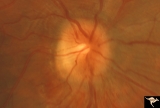 |
Bilateral Severe Hemorrhagic Papilledema | Right eye. 2 months later, resolving Bilateral Severe Hemorrhagic Papilledema. Same eye as P_32a | Image |
| 86 |
 |
Bilateral Severe Hemorrhagic Papilledema | Right eye. Bilateral Severe Hemorrhagic Papilledema in a woman with hyperthyroidism and dural sinus occlusion. | Image |
| 87 |
 |
Bilateral Severe Hemorrhagic Papilledema | Left eye. Bilateral Severe Hemorrhagic Papilledema in a woman with hyperthyroidism and dural sinus occlusion. | Image |
| 88 |
 |
Bilateral Severe Hemorrhagic Papilledema | Left eye. Bilateral hyperacute papilledema with rapid blindess associated with dural sinus occlusion. Both eyes were nearly blind. Boy. | Image |
| 89 |
 |
Buried and Visible Drusen | PP_19b: right eye : visible drusen in an eleven year old girl; PP_19a: left eye with buried drusen. Anatomy: Optic disc Pathology: Drusen of the optic disc Disease/Diagnosis: Drusen of the optic disc Clinical: Normally functioning eye with drusen. | Image |
| 90 |
 |
Buried and Visible Drusen | PP_19a Left eye with buried drusen. PP_19b: right eye : visible drusen. Eleven year old girl. Anatomy: Optic disc. Pathology: Drusen of the optic disc. Disease/Diagnosis: Drusen of the optic disc. Clinical notes: Normally functioning eye with drusen. | Image |
| 91 |
 |
Buried Drusen | 5 year old boy. Bilateral buried drusen. Notice the lumpy nasal disc elevation. This patient had a twin brother whose optic disc drusen were exposed. Anatomy: Optic disc. Pathology: Drusen of the optic disc. Disease/Diagnosis: Drusen of the optic disc. Clinical notes: Normally functioning eye with ... | Image |
| 92 |
 |
Buried Drusen | 5 year old boy. Bilateral buried drusen. Notice the lumpy nasal disc elevation. This patient had a twin brother whose optic disc drusen were exposed. Anatomy: Optic disc. Pathology: Drusen of the optic disc. Disease/Diagnosis: Drusen of the optic disc. Clinical notes: Normally functioning eye with ... | Image |
| 93 |
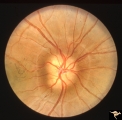 |
Buried Drusen | 7 year old boy with pseudo papilledema from buried drusen. Note the lumpy contour of the disc margin. Also note the surrounding ring-like light reflex that is optically perfect and indicates absence of edema spreading onto the surrounding retina. Anatomy: Optic disc. Pathology: Drusen of the optic d... | Image |
| 94 |
 |
Buried Drusen | Young woman with pseudo papilledema from buried drusen with associated visual field defects. Barely visible in the upper arcuate nerve fibers is a slit like defect. Anatomy: Optic disc. Pathology: Drusen of the optic disc. Disease/Diagnosis: Drusen of the optic disc. Clinical notes: This patient had... | Image |
| 95 |
 |
Buried Drusen | Buried drusen with peculiar white dot, which appears to be choroidal in location. Note lumpy disc margin on right disc PP_15a is right eye. PP_15b is left eye. Beautiful example of pseudo papilledema in which drusen can not be seen. 8 year old girl. Anatomy: Optic disc. Pathology: Drusen of the op... | Image |
| 96 |
 |
Buried Drusen | Suspected buried drusen in a girl. Anatomy: Optic disc. Pathology: Drusen of the optic disc. Disease/Diagnosis: Drusen of the optic disc. Clinical notes: Normally functioning eye with suspected drusen. | Image |
| 97 |
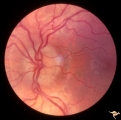 |
Buried Drusen | Left disc has a blurred lumpy margin. Retinal vessels are not obscured in the disc margin blur, therefore no edema is present. This is an example of a difficult blurred disc, the nature of which is clarified by the presence of a clear cut disk anomoly in the fellow eye. 8 year old girl. PP_15a has b... | Image |
| 98 |
 |
Buried Drusen | Buried drusen; PP_13a: Right eye. Note lumpy disc margin, especially temporally. Also note absence of optic cup. Excellent example of pseudo papilledema with buried drusen. Anatomy: Optic disc. Pathology: Drusen of the optic disc. Disease/Diagnosis: Drusen of the optic disc. Clinical notes: Patient ... | Image |
| 99 |
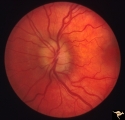 |
Buried Drusen | Buried drusen. Left eye. Note lumpy disc margin, especially temporally. Also note absence of optic cup. Excellent example of pseudo papilledema with buried drusen. Pair with PP_13a. Anatomy: Optic disc. Pathology: Drusen of the optic disc. Disease/Diagnosis: Drusen of the optic disc. Clinical notes... | Image |
| 100 |
 |
Buried Drusen | Excellent example of pseudo papilledema with sub surface drusen at 10:00 and 1:00. Anatomy: Optic disc. Pathology: Drusen of the optic disc. Disease/Diagnosis: Drusen of the optic disc. Clinical notes: Normally functioning eye with drusen. | Image |
| 101 |
 |
Buried Drusen with Choroidal Retinal Scar | Right eye: Buried drusen; probable complication of peripapillary hemorrhage at 7:00. Anatomy: Optic disc. Pathology: Drusen of the optic disc. Disease/Diagnosis: Drusen of the optic disc. Clinical notes: Enlarged blind spot. | Image |
| 102 |
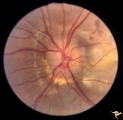 |
Buried Drusen with Sub-retinal Neovascular Net | Buried drusen with sub-retinal neovascular net. Both PP29a and PP29b are left eye: 17 year old girl; Visual acuity 10/400. Anatomy: Optic disc. Pathology: Drusen of the optic disc. Disease/Diagnosis: Drusen of the optic disc. Clinical notes: Loss of central vision due to subretinal neovascularizatio... | Image |
| 103 |
 |
Buried Drusen with Sub-retinal Neovascular Net | Buried drusen with sub-retinal neovascular net. This is the same left eye. Appearance of the central retina of the left eye. Both PP29a & b are left eye: 17 year old girl; Visual acuity 10/400. Anatomy: Optic disc. Pathology: Drusen of the optic disc. DIsease/Diagnosis: Drusen of the optic disc. Cl... | Image |
| 104 |
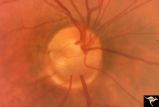 |
C01 Pits of the Optic Disc | Right eye. Very large inferior temporal optic pit. Congenital. Woman. Anatomy: Optic disc. | Image |
| 105 |
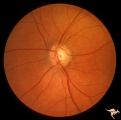 |
C03 Pits of the Optic Disc | Central optic pit. Left eye. Anatomy: Optic disc. | Image |
| 106 |
 |
C04 Pits of the Optic Disc | Right eye. Man. Large temporal pit. Macular detachment. Anatomy: Optic disc. | Image |
| 107 |
 |
C05 Pits of the Optic Disc | Right eye. Pigmented pit. Woman. Anatomy: Optic disc. | Image |
| 108 |
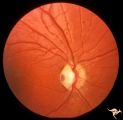 |
C06 Pits of the Optic Disc | Right eye. Temporal pit. 6 year old with see-saw nystagmus. Anatomy: Optic disc. Clinical: Six-year old with see-saw nystagmus. | Image |
| 109 |
 |
C07 Pits of the Optic Disc | Left eye. Temporal pit. Man. Anatomy: Optic disc. | Image |
| 110 |
 |
C08 Pits of the Optic Disc | Left eye. Large cavitary anomaly (pit). Man. 20/100 visual acuity. Superior nasal visual field defect. May not have a central retinal artery. Anatomy: Optic disc. Clinical: Man. 20/100 visual acuity. Superior nasal visual field defect. | Image |
| 111 |
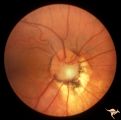 |
C09 Pits of the Optic Disc | Pit with peripapillary choroidal defect. Right eye. Dwarfed boy. May not have a central retinal artery. Same patient as C_10. Anatomy: Optic disc. | Image |
| 112 |
 |
C10 Pits of the Optic Disc | Disc malformation. Abortive cavitary anomaly. Left eye. Dwarfed boy. Same patient as C_9. Anatomy: Optic disc. | Image |
| 113 |
 |
C101 Papillitis, Retrobulbar Neuritis | Resolved. Associated polycythemia. Papillitis after flu in patient with polycythemia. Homosexual male. Anatomy: Optic disc. Pathology: Axoplasmic stasis due to inflammation. Disease/ Diagnosis: Post infectious papillitis. Clinical: Visual loss after the flu.. | Image |
| 114 |
 |
C102 Papillitis, Retrobulbar Neuritis | Inflammatory papillitis in 25 year old woman. Resolved completely. Anatomy: Optic disc. Pathology: Axoplasmic stasis due to inflammation. Disease/ Diagnosis: Inflammatory optic papillitis. Clinical: Visual loss. | Image |
| 115 |
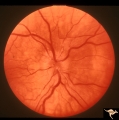 |
C103 Papillitis, Retrobulbar Neuritis | Optic neuritis in infectious mononucleosis. Anatomy: Optic disc. Pathology: Axoplasmic stasis due to inflammation. Disease/ Diagnosis: Optic neuritis with mononucleosis or Epstein Barr Virus. Clinical: Visual loss associated with mononucleosis. | Image |
| 116 |
 |
C104 Papillitis, Retrobulbar Neuritis | Post infectious papillitis with macular exudate. Anatomy: Optic disc macula. Pathology: Axoplasmic stasis due to inflammation with lipid deposit in Henle's layer. Disease/ Diagnosis: Post infectious papillitis/optic neuritis. Clinical: Visual loss after infection. | Image |
| 117 |
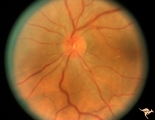 |
C105 Disc Edema with Systemic Lupus | Mild disc edema blurs the inferior disc margin. Flourescein angiogram in D1_06. Same patient as D1_06 an D1_07. Man. Anatomy: Optic disc. Pathology: Axoplasmic stasis due to vasculitis (Lupus). Disease/ Diagnosis: Lupus papillopathy. | Image |
| 118 |
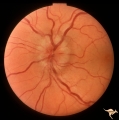 |
C106 Papillitis, Retrobulbar Neuritis | Papillitis with recovery of vision. Woman acupuncturist. Anatomy: Optic disc. Pathology: Axoplasmic stasis after inflammation. Disease/ Diagnosis: Optic neuritis/optic papillitis. Clinical: Visual loss with recovery. | Image |
| 119 |
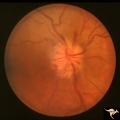 |
C107 Papillitis, Retrobulbar Neuritis | Man with bilateral papillitis. Right eye. Pair with C1_08. Cause unknown. Visual field showed central scotomas. Anatomy: Optic disc. Pathology: Axoplasmic stasis due to inflammation. Disease/ Diagnosis: Neuritis of the optic nerve. Clinical: Visual loss. | Image |
| 120 |
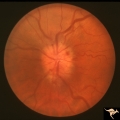 |
C108 Papillitis, Retrobulbar Neuritis | Man with bilateral papillitis. Left eye. Pair with C1_07. Cause unknown. Visual field shows central scotoma. Anatomy: Optic disc. Pathology: Axoplasmic stasis due to inflammation. Disease/ Diagnosis: Optic neuritis / Optic papillitis. Clinical: Visual loss. | Image |
| 121 |
 |
C109 Papillitis, Retrobulbar Neuritis | Optic papillitis after wasp sting. 57 year old woman. Right eye. Anatomy: Optic disc. Pathology: Axoplasmic stasis due to inflammation. Disease/ Diagnosis: Optic neuritis after wasp sting. Clinical: Visual loss after wasp sting. | Image |
| 122 |
 |
C110 Papillitis, Retrobulbar Neuritis | AIDs papillitis. Segmental. Note inflammatory focus on temporal side of disc. 29 year old homosexual male. Visual field shows huge blind spot. Anatomy: Optic disc. Pathology: Axoplasmic stasis due to inflammation. Disease/ Diagnosis: AIDS papillitis / AIDS Optic neuritis. Clinical: Visual symptoms d... | Image |
| 123 |
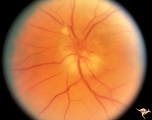 |
C111 Papillitis, Retrobulbar Neuritis | AIDS papillitis. Male. Anatomy: Optic disc. Pathology: Axoplasmic stasis due to inflammation. Disease/ Diagnosis: AIDS papillitis. Clinical: Visual symptoms. | Image |
| 124 |
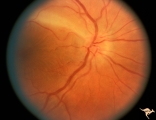 |
C112 Papillitis, Retrobulbar Neuritis | Woman with herpes. Acute retinal necrosis with papillitis and arcuate neuro-retinitis. Right eye. Pair with C1_13. Reference: Margolis T, Irvine AR, Hoyt WF, Hyman R. Acute retinal necrosis syndrome presenting with papillitis and arcuate neuroretinitis. Ophthalmology. 1988 Jul;95(7):937-40. Anatomy:... | Image |
| 125 |
 |
C113 Papillitis, Retrobulbar Neuritis | Woman with herpes. Acute retinal necrosis with papillitis an arcuate neuro-retinitis. Right eye. Notice the large arcuate defect extending fromt he disc to the retina of retinal necrosis. Pair with C1_12. Anatomy: Optic disc; Retina. Pathology: Axoplasmic stasis due to inflammation; Retinal necrosis... | Image |
| 126 |
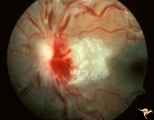 |
C114 Papillitis, Retrobulbar Neuritis | Epstien-Barr Virus papillitis with remarkably good recovery. Steroid responsive. Woman. Anatomy: Optic disc. Pathology: Axoplasmic stasis due to inflammation. Disease/ Diagnosis: Epstein Barr Virus with papillitis. Clinical: Visual loss that was steroid responsive. | Image |
| 127 |
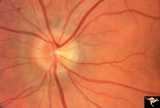 |
C115 Papillitis, Retrobulbar Neuritis | Demyelinative optic neuropathy with mild disc swelling. This eye had a large central scotoma. Note the bland disc margin swelling from 2:00 to 4:00. This swelling constitutes spill over edema from the main focus of the neuritis which lies behind the eyeball. Visual acuity was 2200. Anatomy: Optic di... | Image |
| 128 |
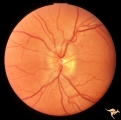 |
C116 Papillitis, Retrobulbar Neuritis | Demyelinative optic neuropathy with mild disc swelling. Note the mild disc margin blurring. The main focus of the neuritis lies behind the eye. 20/20 visual acuity. Anatomy: Optic disc; Optic nerve. Pathology: Axoplasmic stasis due to inflammation; Acute demyelination. Disease/ Diagnosis: Acute sub-... | Image |
| 129 |
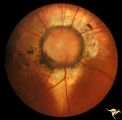 |
C13 Morning Glory Disc | "Morning Glory" disc with peripapillary choroidal defect extending inferiorly. Patient has transphenoidal encephalocele. Note tapering edge like an arrow pointing to patient's basal encephalocele and cleft palate. Reference: Brodsky MC, Hoyt WF, Hoyt CS, Miller NR, Lam BL. Atypical retinochoroidal ... | Image |
| 130 |
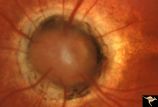 |
C14 Morning Glory Disc | Isolated "Morning Glory". Left eye. Girl. Anatomy: Optic disc. | Image |
| 131 |
 |
C15 Morning Glory Disc | "Morning Glory" disc. Note tapering edge pointing to patient's transphenoidal encephalocele. Reference: Brodsky MC, Hoyt WF, Hoyt CS, Miller NR, Lam BL. Atypical retinochoroidal coloboma in patients with dysplastic optic discs and transphenoidal encephalocele Arch Ophthalmol. 1995 May;113(5):624-8.... | Image |
| 132 |
 |
C16 Morning Glory Disc | "Morning Glory" disc. Note tapering edge pointing to basal encephalocele. Boy. Anatomy: Optic disc. | Image |
| 133 |
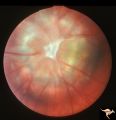 |
C17 Morning Glory Disc | "Morning Glory" disc. CT normal. Anatomy: Optic disc. Clinical: CT normal. | Image |
| 134 |
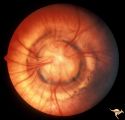 |
C18 Morning Glory Disc | "Morning Glory" disc. 6 month old baby. Anatomy: Optic disc | Image |
| 135 |
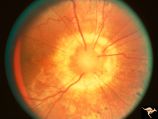 |
C19 Morning Glory Disc | Bilateral "Morning Glory" disc. Right eye. Man. Pair with C_20. Anatomy: Optic disc. | Image |
| 136 |
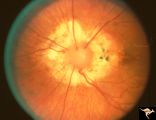 |
C20 Morning Glory Disc | Bilateral "Morning Glory" disc. Left eye. Man. Pair with C_19. Anatomy: Optic disc. | Image |
| 137 |
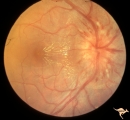 |
C202 Papillitis with Macular Star Cat Scratch Disease. | Proven Bartonella neuroretinitis. 23 year old man. Ocular disc edema with macular star (ODEMS). Anatomy: Optic disc; Retina. Pathology: Axoplasmic stasis due to inflammation; Exudate in Henle's layer. Neuroretinitis due to Bartonella Henslae (or cat scratch). Clinical: Visual blurring; Optic disc sw... | Image |
| 138 |
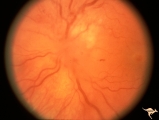 |
C203 Papillitis with Macular Star, Cat Scratch Disease | Proven Bartonella neuroretinitis. Left eye. October 3, 1986. Same eye as C2_04. Macular star visible on C2_04. Woman. Ocular disc edema with macular star (ODEMS). Anatomy: Optic disc; Retina. Pathology: Axoplasmic stasis due to inflammation; Exudates in Henle's layer. Disease/ Diagnosis: Bartonella ... | Image |
| 139 |
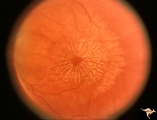 |
C204 Papillitis with Macular Star, Cat Scratch Disease | Proven Bartonella neuroretinitis. Left eye. October 17, 1986. Same eye as C2_03. Ocular disc edema with macular star (ODEMS). Woman. Anatomy: Optic disc; Retina. Pathology: Exudates in Henle's layer. DIsease/ Diagnosis: Neuroretinitis due to Bartonella Henslae (Cat Scratch). Clinical: Visual blurrin... | Image |
| 140 |
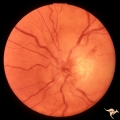 |
C205 Papillitis with Macular Star, Cat Scratch Disease | Proven Bartonella neuroretinitis. Macular star present, but not visible on image. 33 year old woman. Anatomy: Optic disc; Retina. Pathology: Axoplasmic stasis due to inflammation. Disease/ Diagnosis: Bartonella Henslae (Cat Scratch). Clinical: Visual blurring. | Image |
| 141 |
 |
C206 Papillitis with Macular Star, Cat Scratch Disease | Proven Bartonella neuroretinitis. Resolved papillitis with residual retinal exudate. Man. Anatomy: Optic disc; Retina. Pathology: Axoplasmic stasis due to inflammation. Disease/ Diagnosis: Bartonella Henslae (Cat Scratch). Clinical: Visual blurring; Ocular edema with macular star (ODEMS). | Image |
| 142 |
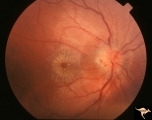 |
C208 Papillitis with Macular Star, Cat Scratch Disease | Proven Bartonella neuroretinitis. Man. Anatomy: Optic disc; Retinitis. Pathology: Axoplasmic stasis due to inflammation. Disease/ Diagnosis: Bartonella Henslae (Cat Scratch). Clinical: Visual blurring; Ocular disc edema with macular star (ODEMS). | Image |
| 143 |
 |
C209 Papillitis with Macular Star, Cat Scratch Disease | Proven Bartonella neuroretinitis. Woman. Anatomy: Optic disc; Retina. Pathology: Axoplasmic stasis due to inflammation. Disease/ Diagnosis: Bartonella Henslae (Cat Scratch). Clinical: Visual blurring without visual field defect; Ocular disc edema with macular star (ODEMS). | Image |
| 144 |
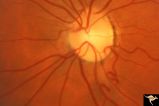 |
C24 Empty Disc | Left eye. Multiple cilioretinal arteries. Child of C_25 Anatomy: Optic disc. | Image |
| 145 |
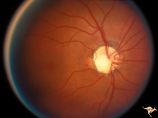 |
C25 Empty Disc | Right eye. Multiple cilioretinal arteries. Visual function normal. Father of C_24. Anatomy: Optic disc | Image |
| 146 |
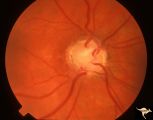 |
C26 Empty Disc | Right eye. Multiple cilioretinal arteries. Patient had dysplastic kidneys. Papillorenal Syndrome (PRS). Hand motion vision. 17 year old girl. Anatomy: Optic disc. | Image |
| 147 |
 |
C27 Empty Disc | Multiple cilioretinal arteries. Chronic interstitial nephritis. Renal and optic disc dysplasia. Papilorenal Syndrome (PRS). No central retinal artery. Anatomy: Optic disc. | Image |
| 148 |
 |
C28 Empty Disc | Left eye. Woman. Multiple cilioretinal vessels. Visual function normal. Anatomy: Optic disc. | Image |
| 149 |
 |
C29 Empty Disc | Left eye. Papilorenal Syndrome (PRS). Pair with C_30. Anatomy: Optic disc. | Image |
| 150 |
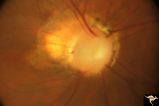 |
C30 Empty Disc | Right eye. Papillorenal Syndrome (PRS). Pair with C_29. Anatomy: Optic disc. | Image |
| 151 |
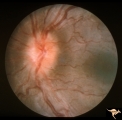 |
C301 Nodular Papillopathies (Sarcoid) | Disc swelling. Sarcoid papillopathy. Note infiltrative nodule at 9:00 on the disc.The patient had proven sarcoid. Perivenous inflammatory cuffing visible on image C3_02. Right eye. Pair with C3_02. Anatomy: Optic disc; Retina. Pathology: Axoplasmic stasis due to sarcoid infiltration. Disease/ Diagn... | Image |
| 152 |
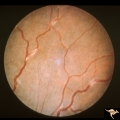 |
C302 Nodular Papillopathies (Sarcoid) | Perivenous Inflammatory Cuffing in a Patient with Proven Sarcoid. Left eye. Pair with C3_01. Anatomy: Retina. Pathology: Axoplasmic stasis due to sarcoid infiltration with retinal venous exudation? Disease/ Diagnosis: Sarcoid papillopathy with perivenous inflammatory disease. Clinical: Unknown? | Image |
| 153 |
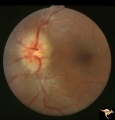 |
C303 Nodular Papillopathies (Sarcoid) | Lumpy infiltrative papillopathy in a patient with proven sarcoid. Anatomy: Optic disc. Pathology: Axoplasmic stasis due to sarcoid infiltration. Disease/ Diagnosis: Sarcoid papillopathy. Clinical: Unknown? | Image |
| 154 |
 |
C304 Nodular Papillopathies (Sarcoid) | Lumpy nodular disc infiltration from sarcoid. Anatomy: Optic disc. Pathology: Axoplasmic stasis due to sarcoid infiltration. Disease/ Diagnosis: Sarcoid papillopathy. Clinical: Unknown? | Image |
| 155 |
 |
C305 Nodular Papillopathies (Sarcoid) | July 1984 shows multiple infiltrative nodules on the optic disc in addition to circumferential subretinal yellow exudates. 32 year old black woman. Same patient as C3_06 and C3_07. Anatomy: Optic disc; Retina. Pathology: Axoplasmic stasis due to sarcoid infiltration and retinal exudation. Disease/ ... | Image |
| 156 |
 |
C306 Nodular Papillopathies (Sarcoid) | Lumpy disc swelling with retinal folds and a macular star in a patient with sarcoid. Presentation in October 1983. Same patient as C3_05 and C3_07. Anatomy: Optic disc; Retina. Pathology: Axoplasmic stasis due to sarcoid infiltration. Disease/ Diagnosis: Axoplasmic stasis due to sarcoid infiltration... | Image |
| 157 |
 |
C307 Nodular Papillopathies (Sarcoid) | Fluorescein angiogram shows striking staining of the sarcoid nodules. July 1984. Same patient as C3_05 and C3_06. Corresponds with July 1984 image, C3_06. Anatomy: Optic disc. Pathology: Axoplasmic stasis due to sarcoid infiltration. Disease/ Diagnosis: Sarcoid papillopathy. Clinical: Unknown? | Image |
| 158 |
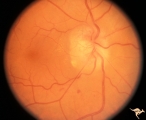 |
C308 Nodular Papillopathies (Sarcoid) | Nodular infiltrative papillopathy in a patient with sarcoid. Woman. Anatomy: Optic disc. Pathology: Axoplasmic stasis due to sarcoid infiltration. Disease/ Diagnosis: Sarcoid papillopahty. Clinical: Unknown? | Image |
| 159 |
 |
C33 Anomalous Pale Disc | Woman. Multiple cilioretinal arteries. Veins all empty into eye. Anomalous venous exit from nasal edge of optic disc. Visual function normal. Pair with C_36. Anatomy: Optic disc. | Image |
| 160 |
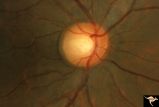 |
C35 Anomalous Pale Disc | Macro disc appears pale because of large diameter. Woman. Right eye. Anatomy: Optic disc. | Image |
| 161 |
 |
C36 Anomalous Pale Disc | Multiple cilioretinal arteries. Pale appearance. Normal optic nerve function. Good example of "empty disc". Pair with C_33. Anatomy: Optic disc. | Image |
| 162 |
 |
C37 Anomalous Pale Disc | "Watermelon" disc. Woman. Normal function. Left eye. Anatomy: Optic disc. | Image |
| 163 |
 |
C38 Anomalous Pale Disc | Megalopapilla in -8 myopic eye. Right eye. Anatomy: Optic disc. Clinical: High myope. | Image |
| 164 |
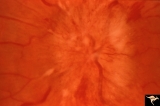 |
C401 Luetic Papillopathy (Gumma of the Optic Disc) | Diffuse optic disc swelling with tortuous capillary dilations indicating inflammatory cellular infiltration. October 2001. Same eye as C4_02. Anatomy: Optic disc. Pathology: Axoplasmic stasis due to syphillitic infection. Luetic papillopathy (Syphyllis). Clinical: Visual loss. | Image |
| 165 |
 |
C402 Luetic Papillopathy (Gumma of the Optic Disc) | November 2001. Same eye as C4_01 after treatment with penicillin. Disc swelling went away and good visual function returned. Anatomy: Optic disc. Pathology: Axoplasmic stasis due to syphillitic infection. Disease/ Diagnosis: Luetic papillopathy (Syphillis). Clinical: Improving visual loss. | Image |
| 166 |
 |
Cerebellar Macular Degeneration | Cerebellar retinal degeneration with narrowed arterioles. Disc pallor. Granular retinal degeneration. 10 year old boy with mental degenerations and seizures. Anatomy: Retina. Pathology: Optic atrophy. Disease/Diagnosis: Congenital retinal cerebellar degeneration. Clinical: Severe mental retardation ... | Image |
| 167 |
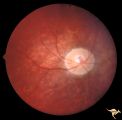 |
Cerebellar Macular Degeneration | Cerebellar retinal degenerative disease in a 12 year old boy who was blind and demented. His siblings were also blind. Was referred to as Voght-Spielmeyer Disease (Pair with R2_B1_3b shows granular retinal degeneration.) Anatomy: Retina. Pathology: Optic atrophy. Disease/Diagnosis: Congenital retina... | Image |
| 168 |
 |
Cerebellar Macular Degeneration | Cerebellar macular degeneration in a 7 year old boy with blindness. Rectal biopsy positive for storage material. Nature of cerebral degeneration was not defined in era when picture was taken. Sister also had similar findings. Anatomy: Retina. Pathology: Optic atrophy. Disease/Diagnosis: Congenital r... | Image |
| 169 |
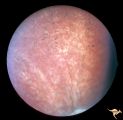 |
Cerebellar Macular Degeneration | Cerebellar retinal degenerative disease in a 12 year old boy who was blind and demented. His siblings were also blind. Was referred to as Vogt-Spielmeyer Disease. Pair with R2_B1_3a. Anatomy: Retina. Pathology: Optic atrophy. Disease/Diagnosis: Congenital retinal cerebral degeneration. Clinical: Sev... | Image |
| 170 |
 |
Cerebellar Macular Degenerative Disease | Ocular fundus shows prominent retinal degeneration in the region of the maculae, bilateral optic disc pallor with narrowed retinal arterioles. Interesting peripapillary halo of retinal pigment degeneration. Most consistent with Spinal Cerebellar Degeneration Type 7 (SCA-7). Anatomy: Retina. Patholog... | Image |
| 171 |
 |
Cerebellar Macular Degenerative Disease | Ocular fundus shows prominent retinal degeneration in the region of the maculae, bilateral optic disc pallor with narrowed retinal arterioles. Interesting peripapillary halo of retinal pigment degeneration. Most consistent with Spinal Cerebellar Degeneration Type 7 (SCA-7). Anatomy: Retina. Patholog... | Image |
| 172 |
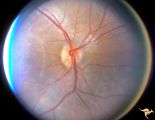 |
Cerebellar Macular Degenerative Disease | Cerebellar degeneration with granular maculae changes and bone spicules. Right eye. Anatomy: Retina. Pathology: Cerebellar macular degenerative disease. Disease/Diagnosis: Spinal Cerebellar Degeneration Type 7 (SCA-7). Clinical notes: Blindness and cerebellar degeneration. | Image |
| 173 |
 |
Cerebellar Macular Degenerative Disease | Cerebellar degeneration with granular maculae changes and bone spicules. Right eye. Anatomy: Retina. Pathology: Cerebellar macular degenerative disease. Disease/Diagnosis: Spinal Cerebellar Degeneration Type 7 (SCA-7). Clinical notes: Blindness and cerebellar degeneration. | Image |
| 174 |
 |
Cerebellar Macular Degenerative Disease | Cerebellar degeneration with granular maculae changes and bone spicules. Left eye. Anatomy: Retina. Pathology: Cerebellar macular degenerative disease. Disease/Diagnosis: Spinal Cerebellar Degeneration Type 7 (SCA-7). Clinical notes: Blindness and cerebellar degeneration. | Image |
| 175 |
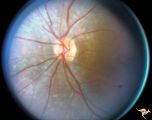 |
Cerebellar Macular Degenerative Disease | Cerebellar degeneration with granular maculae changes and bone spicules. Left eye. Anatomy: Retina. Pathology: Cerebellar macular degenerative disease. Disease/Diagnosis: Spinal Cerebellar Degeneration Type 7 (SCA-7). Clinical: Blindness and cerebellar degeneration. | Image |
| 176 |
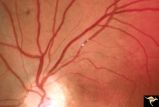 |
Cerebroretinal Microangiopathy (Susac Syndrome) | Two plaques which have been called Psuedo-emboli. This plaque is not the result of embolism, but is the result of the microangioplastic process underlying the syndrome. (NANOS 2001 by Egan, RA). Anatomy: Retina. Pathology: Microangiopathy involving brain, auditory nerve and retina. Disease/Diagnosi... | Image |
| 177 |
 |
Cerebroretinal Microangiopathy (Susac Syndrome) | Retinal signs of Susac's Syndrome in acute phase consist of areas of retinal artery infarction from branch retinal artery occlusions. This fundus shows two area of retinal infarction from occlusion of both superior and inferior branch retinal arterioles. Anatomy: Retina. Pathology: Microangiopathy... | Image |
| 178 |
 |
Cerebroretinal Microangiopathy (Susac Syndrome) | Retinal signs of Susac's Syndrome in acute phase consist of areas of retinal artery infarction from branch retinal artery occlusions. These patients are usually women, many of whom are demented and have hearing loss. Refs: 1) Susac, Hardiman, Sellhorst. Neurology. 1979. 29:313-316 2) Susac ""Susa... | Image |
| 179 |
 |
Cerebroretinal Microangiopathy (Susac Syndrome) | This fundus picture from a patient with Susac Syndrome shows a focal shiny plaque in the inferior retinal arteriole. This plaque is not the result of embolism, but is the result of the microangioplastic process underlying the syndrome. (NANOS 2001 by Egan, RA). Anatomy: Retina. Pathology: Microangi... | Image |
| 180 |
 |
Cerebroretinal Microangiopathy (Susac Syndrome) | Retinal signs of Susac's Syndrome in acute phase consist of areas of retinal artery infarction from branch retinal artery occlusions. Shows clearing retinal branch artery occlusion. Pathology: Retina. Pathology: Microangiopathy involving brain, auditory nerve and retina. Disease/Diagnosis: Cerebro... | Image |
| 181 |
 |
Cerebroretinal Microangiopathy (Susac Syndrome) | Retinal signs of Susac's Syndrome in acute phase consist of areas of retinal artery infarction from branch retinal artery occlusions. Branch artery occlusion beginning to clear. Note the occluded arteriole lying on top of the infarcted zone. Anatomy: Retina. Pathology: Microangiopathy involving br... | Image |
| 182 |
 |
Cerebroretinal Microangiopathy (Susac Syndrome) | There is a plaque superior to the disc at 12:00. This plaque is not the result of embolism, but is the result of the microangioplastic process underlying the syndrome. There is a ghost vessel inferiorly at 5:00 off the disc. (NANOS 2001 by Egan, RA). Anatomy: Retina. Pathology: Microangiopathy invo... | Image |
| 183 |
 |
Cerebroretinal Microangiopathy (Susac Syndrome) | There is an occlusion of the superior nasal retinal arteriole visible as a white ghost vessel at 11:00. Note: Collateral filling of the distal branches in two places. (NANOS 2001 by Egan, RA). Anatomy: Retina. Pathology: Microangiopathy involving brain, auditory nerve and retina. Disease/Diagnosis:... | Image |
| 184 |
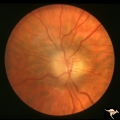 |
Chronic Atrophic Papilledema | Left eye. Left eye blind. Chronic Atrophic Papilledema. Obese woman (300 lbs) with large tentorial meningioma. "Pseudo Pseudotumor". Anatomy: Optic disc. Pathology: Papilledema. Disease/Diagnosis: Papilledema from large tentorial meningioma. | Image |
| 185 |
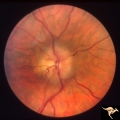 |
Chronic Atrophic Papilledema | Right eye. Chronic Atrophic Papilledema. Obese woman (300 lbs) with large tentorial meningioma. "Pseudo Pseudotumor" Anatomy: Optic disc. Pathology: Papilledema. Disease/Diagnosis: Papilledema from large tentorial meningioma. | Image |
| 186 |
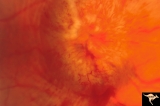 |
Chronic Papilledema due to Brain Tumor | Right eye. Chronic papilledema wth white centrally located exudates in a man with hemispheric glioma. Anatomy: Optic disc. Pathology: Papilledema. Disease/Diagnosis: Chronic papilledema. | Image |
| 187 |
 |
Chronic Papilledema due to Brain Tumor | Left eye. Chronic papilledema with white centrally located exudates in a man with hemispheric glioma. Anatomy: Optic disc. Pathology: Papilledema. Disease/Diagnosis: Chronic papilledema. | Image |
| 188 |
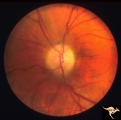 |
Chronic Papilledema due to Brain Tumor - Resolved | Left eye - same as P_40b - follow up after 4 months. Chronic papilledema resolved after treatment showing residual atrophy. | Image |
| 189 |
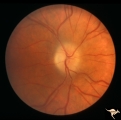 |
Chronic Papilledema due to Brain Tumor - Resolved | Right eye - same as P_40a - follow up after 4 months. Chronic papilledema resolved after treatment showing residual atrophy. Anatomy: Optic disc. Pathology: Papilledema. Disease/Diagnosis: Chronic papilledema. | Image |
| 190 |
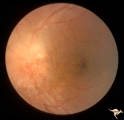 |
Chronic Papilledema in Resolution. Sequence | Left eye 2 weeks after presentation. Chronic papilledema in resolution. Note first evidence of a vertical choroidal fold. Anatomy: Optic disc. Pathology: Papilledema. Disease/Diagnosis: Papilledema. | Image |
| 191 |
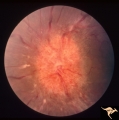 |
Chronic Papilledema in Resolution. Sequence | Left eye at presentation. Chronic papilledema. Anatomy: Optic disc Pathology: Papilledema Disease/Diagnosis: Papilledema | Image |
| 192 |
 |
Chronic Papilledema with Hemorrhagic and Exudative Complications | Left eye one month after presentation. Resolving hemorrhage. Chronic papilledema with hemorrhagic and exudative complications due to Pseudotumor cerebri. Anatomy: Optic disc. Pathology: Papilledema. Disease/Diagnosis: Chronic papilledema with hemorrhagic and exudative complications | Image |
| 193 |
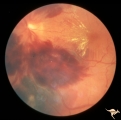 |
Chronic Papilledema with Hemorrhagic and Exudative Complications | Left eye at presesntation. Chronic papilledema with hemorrhagic and exudative complications due to Pseudotumor cerebri. Anatomy: Optic disc Pathology: Papilledema Disease/Diagnosis: Chronic papilledema with hemorrhagic and exudative complications. | Image |
| 194 |
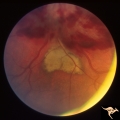 |
Chronic Papilledema with Hemorrhagic and Exudative Complications | Left eye one month after presentation. View below of resolving subretinal hemorrhage. Chronic papilledema with hemorrhagic and exudative complications due to Pseudotumor cerebri. | Image |
| 195 |
 |
Chronic Papilledema with Hemorrhagic and Exudative Complications | Left eye one month after presentation. View above of resolving preretinal hemorrhage. Chronic papilledema with hemorrhagic and exudative complications due to Pseudotumor cerebri. | Image |
| 196 |
 |
Chronic Papilledema with Pseudo Drusen | Left eye. Chronic papilledema with pseudo drusen due to cerebral pontine angle tumor. Anatomy: Optic disc. Pathology: Papilledema Disease/Diagnosis: Chronic papilledema with pseudo drusen. | Image |
| 197 |
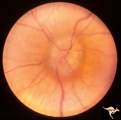 |
Chronic Papilledema with Pseudo Drusen | Right eye. Chronic papilledema with pseudo drusen due to cerebral pontine angle tumor. Anatomy: Optic disc Pathology: Papilledema Disease/Diagnosis: Chronic papilledema with pseudo drusen | Image |
| 198 |
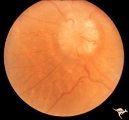 |
Chronic Papilledema with Pseudo Drusen | Right eye. Meningioma. Pseudo drusen from chronic papilledema. Woman. Anatomy: Optic disc Pathology: Papilledema Disease/Diagnosis: Chronic papilledema with pseudo drusen | Image |
| 199 |
 |
Chronic Papilledema with Pseudo Drusen | Left eye. Meningioma. Pseudo drusen from chronic papilledema. The patient's meningioma had blinded her left eye and caused chronic elevated intracranial pressure. Woman. Anatomy: Optic disc Pathology: Papilledema Disease/Diagnosis: Chronic papilledema with pseudo drusen | Image |
| 200 |
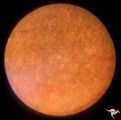 |
Congenital Retinal Cerebellar Degeneration | Congenital retinal blindness due to cerebellar degeneration syndrome. Granular retinal pigmentary degeneration. Pair with R2_B1_1a. Anatomy: Retina. Pathology: Optic atrophy. Disease/Diagnosis: Congenital retinal cerebellar degeneration. Clinical: Severe mental retardation and blindness. | Image |
